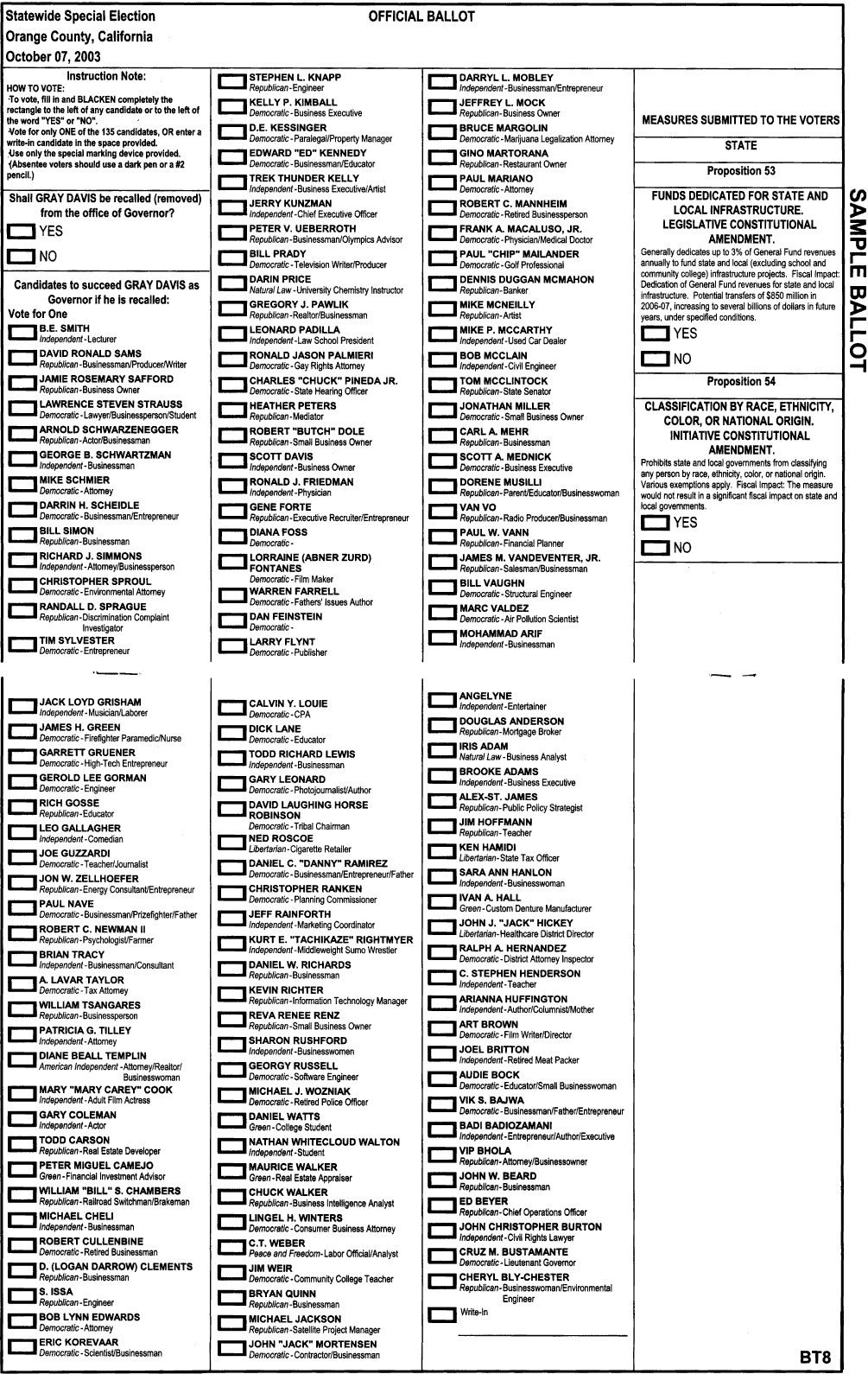4.6 Chapter Summary
Real Life Example: California’s Total Recall Election

In 2003, there was an organized effort to recall California Governor Gray Davis. Around this time, the collapse of the dot-com bubble and the State’s energy crisis had largely been blamed on Governor Davis (Lawrence, 2003). California law stipulates that a recall election can be triggered if a petition is presented that has been signed by 12% of eligible voters from the previous election (Government of California, 2024). Once the petition has been verified, a recall election is triggered. The 2003 effort was successful due in part to a paid signature drive by a petition management company that was hired by the Governor’s opponents (Ballotpedia, n.d.-b).
The recall ballot contains two questions:
- Shall GRAY DAVIS be recalled (removed) from the office of Governor?
- Who would you pick as a replacement?
Unlike other state-level elections, which require primary elections to nominate candidates, recall elections are open to anyone! This election attracted politicians, journalists, adult film stars, and many others.

Of the ballot of 100 candidates, one name stood out: actor Arnold Schwarzenegger. In a very crowded race, Shwaeznegger’s name recognition propelled him to victory as the new Governor of California with 48% of the votes.

What do you think?
Recall elections can be used to remove someone from office – even if they have just been elected! Do you think that’s a good thing?
Further Reading & Resources
If you’d like to learn more about this topic, check out the following articles:
-
-
- Read about Electoral Reform from Fair Vote Canada
- Learn more about the Electoral College in Attenuated Democracy.
-
Chapter Summary
In this chapter,
- Electoral systems are sets of rules that determine how votes are translated into seats; they vary by district structure, ballot design, vote-counting methods, and winning thresholds, influencing both election outcomes and democratic representation.
- Majoritarian systems, such as plurality (First Past the Post) or majority-based methods, aim for clear winners. They can result in candidates winning without a majority of votes and often lead to majority governments with two dominant parties.
- Plurality systems like Canada’s SMP are simple and fast but often unrepresentative, as winners can be elected with less than half of the vote. Variants include runoff elections and ranked-choice voting to ensure majority support.
- Proportional representation (PR) systems allocate seats based on the proportion of votes each party receives, using party lists in multimember districts. PR aims to better reflect voter preferences, but often results in coalition governments.
- Closed and open list PR systems differ in voter influence: closed lists are set by parties, while open lists let voters rank candidates. PR systems may impose minimum thresholds to limit fragmentation by small parties.
- Comparing systems, PR encourages more representative results and multiple parties, but may create unstable coalitions and delay vote counts. Plurality systems are faster and simpler but risk misrepresenting the popular will.
- Mixed Member Proportional (MMP) systems, like those in New Zealand and Germany, combine local representation with proportional outcomes, allowing voters to cast two votes—one for a candidate, one for a party.
- Other election types include referendums for public decision-making and recall elections to remove officials mid-term. The U.S. Electoral College is a unique indirect system that can lead to outcomes where the popular vote winner loses.
OpenAI. (2025, May 30th). ChatGPT. [Large language model]. https://www.chatgpt.com Prompt: Summarize the passage into 8 key points with no additional bullets. Edited & Reviewed by author.
Key Terms
- Alternate vote (AV) system is when voters are asked to rank their choices.
- Coalition government – requires the parties to work together and form a partnership.
- Direct democracy – is a form of government in which citizens have the direct power to make decisions on laws and policies, rather than electing representatives to make those decisions on their behalf. This is often done through tools like referendums, initiatives, and citizen assemblies.
- Electoral College – when each state has a given number of electoral votes to allocate, and on election day, the voters in each state decide which candidate should get their votes.
- Electoral reform – when a country wants to change some aspect of its electoral system.
- Electoral system – A set of rules and methods used to determine how votes are cast, counted, and translated into seats in a legislature or who wins an election.
- Majoritarian – A type of electoral system where the candidate or party that receives the majority of votes (more than half or the most votes, depending on the rule) wins. It emphasizes clear winners and stable governments.
- Majority Government – where one party controls a majority of seats.
- Mixed Member Proportional (MMP) system combines elements of FPTP and plurality systems. With a mixed system, voters cast two votes, one for a local representative (typically in a single-member district) and a second vote for a political party.
- Party lists are a type of electoral system in which political parties present a list of candidates to voters
- Plurality – A decision rule where the candidate with the most votes wins, regardless of whether they have a majority. Also known as “First Past the Post” (FPTP).
- Popular Vote – winning the total number of votes.
- Proportional – Refers to an electoral system in which seats in a legislature are allocated in proportion to the number of votes each party receives. It aims to reflect voter preferences more accurately.
- Referendum – A direct vote by the electorate on a specific proposal, law, or constitutional amendment. The result may be binding or advisory.
- Recall – A process that allows voters to remove an elected official from office before the end of their term, usually through a petition and a special election.
- Single-member majority system (SMM) to win an election, a candidate must achieve a majority of support in the district instead of simply getting the most votes (O’Neal, 1993).
- Threshold – The minimum level of support (usually a percentage of votes) that a party or candidate must receive to gain representation or proceed to the next stage in an election.
- Two-round system uses two separate elections to determine a winner in each district.

